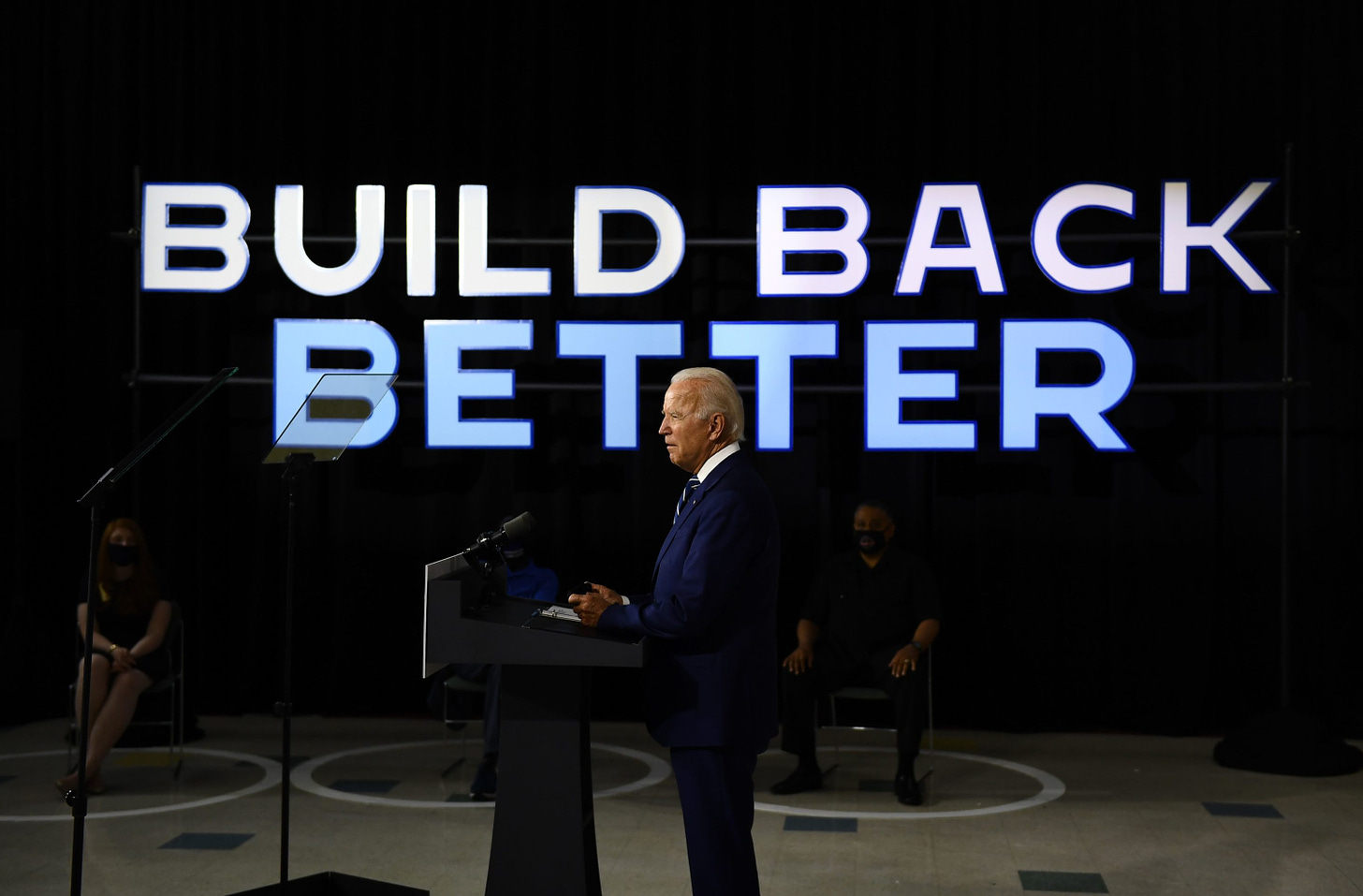Biden’s Policy Agenda Is Bold But Not Radical
From housing to trade to education, his proposals aim to revitalize the country while maximizing political support.

As Joe Biden heads into a presumably unifying convention buoyed by his prudent yet historic choice of Kamala Harris, those still worried about his political skills, or ambitions if elected, can look to the specifics of his agenda.
Issue upon issue, he has crafted a program that responds to the urgency of a socially ruinous pandemic, while avoiding the left-wing poison pills which might cost him crucial voters. This not only enhances his prospects of winning but of getting something done. Taken together, his plans are an aggressive but practical response to the social inequities that weaken our society.
Exhibit A is healthcare. Biden proposes to expand the public option by adding it to the exchanges created by Obamacare, increasing the subsidy which helps the uninsured buy coverage, and lowering the eligibility age for Medicare to 60. But despite pressure from his left, he refuses to endorse a single-payer system that would eradicate the private health insurance valued by millions of Americans.
Instead, Biden has melded universal pre-K, childcare, and eldercare into a program—costing $775 billion over ten years—with a cohesive theme: helping vulnerable Americans, their families, and those who provide them with essential care. Critically, he stresses how quality care—or its absence—impacts the economy.
As his campaign website elaborates: “The pandemic has laid bare just how hard it is for people in this country to find access to quality caregiving they need for themselves, or to juggle the responsibilities of working and also caring for family members.” The campaign estimates that the plan will help create 5 million additional jobs, including new caregiving positions and opportunities filled by Americans liberated to seek them.
Having lost his first wife and a daughter in a car wreck that injured his two sons, Biden draws on his own experience to engage today’s struggling families: “I know how hard it is to be a single dad who has to work with two young sons at home. I know what it means to bring your aging parent into your home to take care of them in her final years. I’ve done both. And it’s hard. And it’s hard for millions of Americans who are just trying to make ends meet.”
Biden’s plan also addresses the dilemma of seniors who would prefer to live at home rather than in often substandard senior facilities, but cannot afford to do so—a problem that the pandemic has spotlit. Finally, Biden promises child-care workers and preschool teachers better pay, health benefits, and the ability to unionize.
By emphasizing that we all have a stake in helping families, Biden prioritizes the stability, security, and cohesion which undergirds societal health.
Similarly, Biden would triple federal aid to low-income schools and districts, enabling them to pay teachers more, establish preschool programs, and make advanced coursework like AP classes universally available—aid particularly critical for schools financially ravaged by the pandemic. His plan would provide free college for families earning less than $125,000 a year—avoiding Bernie Sanders’s costly gift of free college for those who can afford it.
Further, Biden would boost funding for community college—that building block of upward mobility—and double Pell grants which help the disadvantaged attend college. By these carefully targeted initiatives, he means to expand educational opportunity for those who need it most.
For working-class Americans, Biden proposes to redress the 40-year imbalance between employers and workers, increasing the federal minimum wage to $15 an hour while, if possible, repealing the provisions of federal law that allow states to pass “right-to-work” laws—thereby protecting the right to organize. He also promises to “create a cabinet-level working group that will solely focus on promoting union organizing and collective bargaining in the public and private sectors.” Those who object to such measures should consider how mercilessly the pandemic has exposed the vulnerability of working families—and how damaging this is to our economic and social fabric.
Perhaps equally contentious, but politically savvy, is Biden’s plan to bring back jobs by investing in American technology, manufacturing, and research—a response to Trump’s ill-advised tariffs and economic xenophobia. Particularly arresting is his proposal during the primary season to renegotiate the Trans-Pacific Partnership, a potential bulwark against Chinese economic dominance of Asia which Trump foolishly abandoned. Its revival, if crafted to satisfy organized labor, might attract bipartisan support.
Another grave inequity exposed by the pandemic is the yawning wealth gap between whites and minorities, conspicuously African Americans, which leads to a host of related social pathologies. Biden calls for investing $30 billion in a business-opportunity fund for black, brown, and Native American entrepreneurs, and tripling the goal for federal contracting with minority businesses.
The coronavirus also underscores America’s housing insecurity, as well as a principal component of the wealth gap—homeownership. Biden’s ambitious housing agenda begins by fully funding the federal housing voucher program to ensure that all eligible families benefit. Further, Biden would use federal transportation funding to leverage changes in regulatory barriers to building affordable housing, often of medium to high density. The latter, no doubt, inspired Trump’s charge that Biden would “destroy” the suburbs.
But Biden’s proposals should be considered against the history of federal policies which encouraged redlining—thereby excluding many blacks from receiving mortgages, and black neighborhoods from federal housing assistance. Effectively, Biden would reverse decades of embedded discrimination against African Americans. Let Trump, if he chooses, make his charge explicit: “Joe Biden is bringing blacks to your neighborhood.”
Finally, Biden would create an emergency housing support program, and institute a refundable tax credit of up to $15,000 to help families purchase their first home. In a country where family wealth is founded on homeownership, this is an investment in our overall economic health.
As the physical evidence of its ravages proliferates, climate change is no longer a concern largely confined to progressives and the young. Increasingly, polling shows, a majority of voters across the demographic and ideological spectrum understand that it is real; that human beings have contributed to it; that we need to respond more proactively; and that Trump has failed to do so. Here, as elsewhere, Biden has walked a careful line calculated to maximize support.
As a practical politician, he has opposed a total ban on fracking—dangerous in electorally crucial Pennsylvania—and declined to explicitly sign off on the Green New Deal. Instead, he put together a task force on climate, co-chaired by John Kerry and Alexandria Ocasio-Cortez, charged with crafting a unifying agenda.
The result, far more ambitious than Biden’s original proposals, was summarized by the Washington Post as an “aggressive and extensive plan that called for the elimination of carbon pollution from the electric sector by 2035, for the U.S. to rejoin the international Paris climate accord and spend $2 trillion over four years to boost renewables and create incentives for more energy-efficient cars, homes and commercial buildings.”
This has helped rally the support of climate activists. Beyond that, the Post reports: “Biden has framed his climate plan as a jobs program, making clear that he is prepared to pour unprecedented resources into transitioning the United States away from fossil fuels as part of the effort to boost an economy battered by the pandemic.”
Biden’s message on climate policy, the Guardian elaborates, is “vote to put Americans back to work installing millions of solar panels and tens of thousands of wind turbines, making the steel for those projects, manufacturing electric vehicles for the world and shipping them from US ports.” Finally, Biden proposes to channel 40 percent of the money he would spend on clean energy to historically disadvantaged communities.
On the contentious issue of immigration, Biden avoids brain-dead sloganeering about abolishing ICE or decriminalizing the border. But he is also well aware that he lacks fervent support among many Hispanics.
Accordingly, he proposes to end family separation, provide a pathway to citizenship for undocumented immigrants, protect ‘Dreamers,’ and invest $4 billion in Guatemala, Honduras and El Salvador over four years to ameliorate the conditions which caused a desperate mass migration north.
That may sound familiar. But if Biden can accomplish these things—and with a Democratic majority in Congress, he might—it would be an historic breakthrough in our attenuated legislative logjam over immigration.
Finally, there is an issue second only to the pandemic in our national consciousness at the moment: discriminatory law enforcement and unwarranted violence against African Americans.
Here, smartly, Biden opposes “defunding the police.” Instead he would increase support for community policing, reform qualified immunity in cases of alleged police misconduct, create a national roster of police officers who have abused their authority, and end cash bail and mandatory minimum sentences. These are meaningful proposals which could attract broad support in a public newly awakened to the corrosive inequities in our criminal justice system.
If elected, Biden will not be able to pass every policy he proposes; no president can. And with respect to funding his ambitions, he remains artfully unspecific. But he has laid down his marker: Like Franklin Roosevelt, he intends to be a pragmatic but consequential president who helps America surmount difficult times.
In 2021, nothing less will do.





